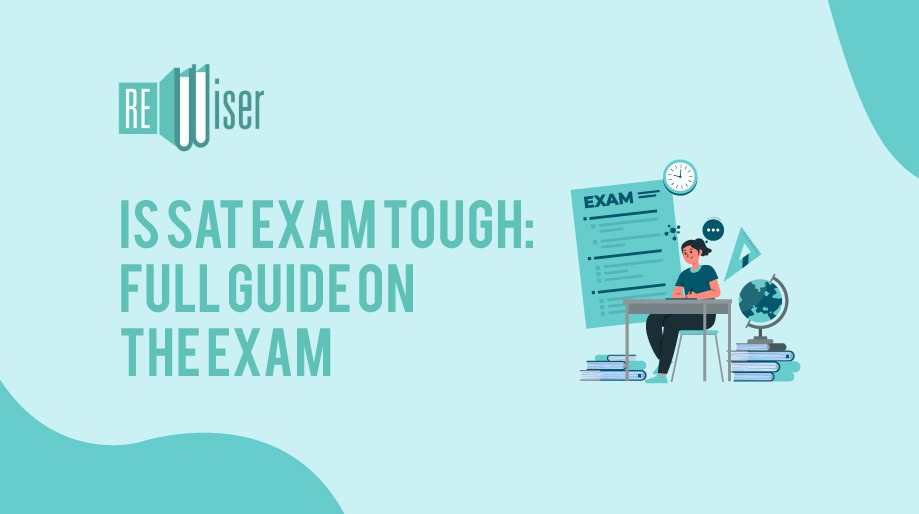
Students often find the SAT Exams challenging. It looks like it’s almost impossible to sit for a four-hour SAT test with constrained time limits that are chock full of reading passages and tricky math problems. It all comes down to what type of test-taker you are. With nearly 2.2 million students taking the SAT every year, according to the College Board, there are bound to be some students who struggle with its testing style. So, is SAT Exam Tough? If not, then here is how to reduce its difficulty level.
Table of Contents:
- How Much is SAT Hard?
- Is the SAT Difficult or Harder Than the PSAT?
- Why is SAT Tough? Important Key Factors
- Tips to Make the SAT Exam Easier for You
- Conclusion
How Much Is SAT Hard?
The difficulty level of the SAT varies from students based on students’ academic strengths, preparation, and test-taking skills.
Covering mathematics, evidence-based readings, and writing, the SATs offers a broad range of high school-level knowledge. For those proficient in the covered subjects and familiar with the test format, it might be less challenging.
However, for students who struggle with exams or those areas of study, it can be quite daunting. Adequate preparations, including taking practice tests and engaging in tutoring, can make the experience more manageable. While the SAT is difficult, with proper preparation and strategy, many students can achieve their desired scores.
Is the SAT difficult or harder than the PSAT?
Many students take the PSAT during their sophomore or junior year of high school. The PSAT is easier than the SAT. It has a more extensive format higher-level questions, and is scored on a broader scale. While the PSAT is designed as a preliminary test to give students an idea of the SAT format and to identify areas for improvement, the SAT is the exam colleges typically consider for admissions. Proper preparation is crucial for both tests. Here are some main factors where both these are difficult –
Content Difficulty – The PSAT tests the same content areas as the SAT, with the question format in the same way. The SAT is more challenging than the PSAT, however, because the PSAT is designed to be a practice exam. PSAT questions are largely based on the content covered in higher school so far.
Length and Timing – There’s a notable difference between the SAT and PSAT in both length and time. The SAT requires more hard work because you must answer more questions in a shorter duration. The SAT is a 3-hour exam with 154 questions.
The PSAT, on the other hand, is 15 minutes shorter and comprises only 139 questions. On the SAT, you will need to work at a faster pace while still maintaining accuracy.
Scoring – The PSAT uses a different scoring range as compared to the SAT. The PSAT is scored between 320 and 1520, while the SAT is scored from 400 to 1600. Though PSAT scores do correlate to SAT scores, your PSAT percentile ranking and your SAT percentile ranking will not align.
Why is SAT Tough? Important Key Factors
Broad Content Scope – The SAT Exam covers a wide range of topics in mathematics, evidence-based readings, and writing, demanding a comprehensive understanding of high school-level subjects.
Time Pressure – With limited time allocated for each section, students must make a balance of accuracy with speed, which can be stressful and challenging.
Complex Question Types – The SAT includes tricky question formats like student-produced response questions in math or evidence-support questions in reading that require higher-order thinking skills.
Endurance – Being a long test, maintenance focus, and consistent performance throughout can be mentally exhausting.
High Risks – Knowing that colleges use the SAT for admissions decisions can add psychological pressure, making the test feel even more challenging.
Tips to Make the SAT Exam Easier for You
The SAT doesn’t need to be a stressful and overwhelming experience for students. Here are some things you can do to prepare for test day and make it less difficult.
Focus on what you can handle: There will be quite a few factors to handle when you prepare for the SAT. But you can take charge of these factors, like managing your anxiety. You can also understand what the question is asking you to do. By familiarizing yourself with the question structure, you can avoid common errors and multiple-choice questions.
Create a Study Schedule: One of the best ways to prepare for the SAT is to create a study schedule. It means you will need to allocate time each week to studying and preparing. Taking one or two practice tests may only have minimum benefits. Pre-up for the test on a schedule set, which can help your routine address areas where you may need more practice.
Work on Increasing Your Reading Speed: Your reading rate can substantially impact your SAT score. Since your goal is to clear the exam as quickly and accurately as possible, you need to be able to get through a passage quickly while still understanding it. One way to help with your pace is to effectively skim passages by reading the introductory paragraph, the first and last sentence of the body paragraph, and then the concluding paragraph.
If you need additional support for your SAT Exam Syllabus, then you can contact Team ReWiser: Contact Us – ReWiser
Conclusion –
The SAT, with its broad content scope and intricate question types, undoubtedly brings challenges. Time constraints and the high stakes associated with college admissions amplify its difficulty. However, with targeted preparation and familiarity with the exam format, students can navigate the SAT more effectively and achieve excellent scores.

